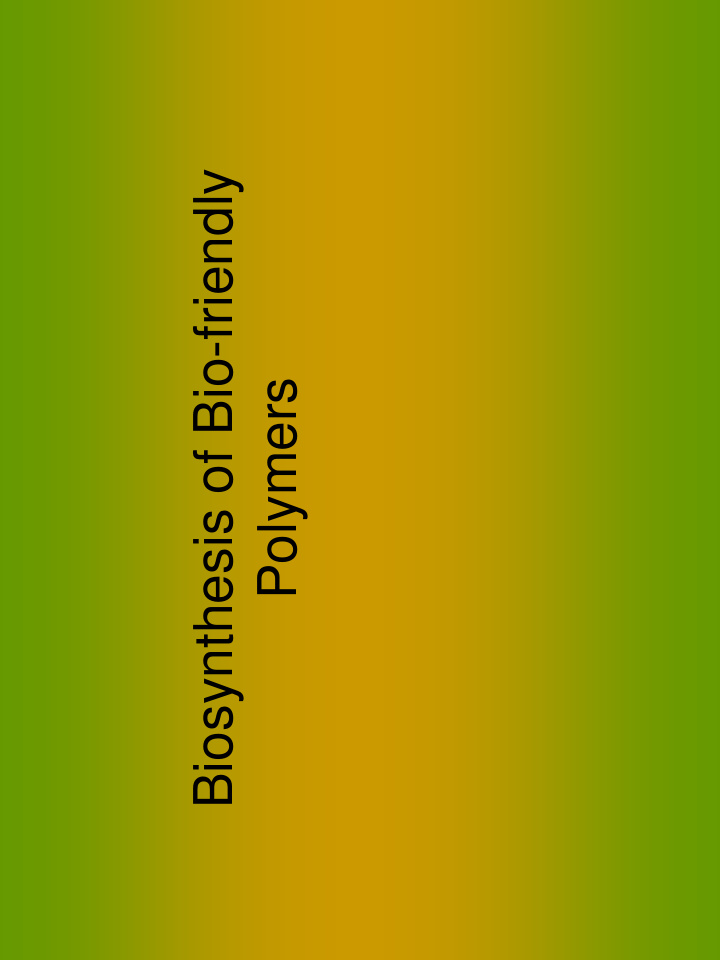



Biosynthesis of Bio-friendly Polymers
U.S. Wood, Paper and Hydrocarbons • U.S. forest product industry – 1.3 million employees – Estimated payroll of 50 billion dollars • U.S. imports of paper and wood products have increased – Closure of 350 paper and wood mills (1995-2005) – Loss of more than 150,000 jobs • 2005 oil consumption 20.8 million barrels/day • Imported hydrocarbons make of 59% total consumption – 20% result in plastics and chemical building blocks
Biocatalysts in Organic Chemistry • Advantages of Biocatalysts – Mild reaction conditions – High stereoselectivity – Do not require co-factors – Catalysts recyclability – Avoid organic solvents and toxic catalysts • Common Biocatalysts – Lipases (i.e. Candida antartica, Psuedomonas cepacia , etc.)
Candida antarctica lipase B • Isolated in 1990 • 33 kDa • 2 binding sites – Acyl-binding site – Alcohol binding site • Member of Serine Hydrolase class • Catalytic ability up to 130°C Taken from Raza et al. Protein Science (2001), 10:329-338.
CALB catalyzed Polymerization Reactions Ring-opening polymerization of lactones, carbonates, depsipeptides, etc. O O O O Lipase n Esterification and Transesterifications O O Lipase + O O y HO OH HO OH x n y x O O
CALB catalyzed Bond Formation Amide Bonds: Aminolysis and Ammonolysis of esters O O O O R 2 Lipase, NH 3 Lipase, R 3 NH 2 , R O R OEt R NHR 3 R NH 2 Carbamate Bonds: Alkoxycarbonylation of vinyl carbonates O O Lipase + H 2 N R 2 R 1 O O R 1 O N R 2 H Carbon-Carbon bonds: Michael additions and Aldol reactions R 1 O R 2 O O Lipase + R 1 R 1 O O R 2 O R 1 + O O O OH Lipase +
More Possibilities O O O O CALB, 70 °C H O O + O + H 2 N O OH NH O NH H H O NH 2 Solvent O O CALB, 95 °C O O O O NH NH O O 2 n O O
Michael Acceptors O O O O Methyl methacrylate 3-methylcyclohex-2-enone 2-cyclohexen-1-one Michael Donors HS N HS SH H SH HS 1,3-propanedithiol diethylamine 1,2-ethyldithiol 1-butanethiol NH 2 HS HS SH N H 1-pentanethiol 1,5-pentanedithiol n-phenylethylenediamine
Current Investigations CALB N + HS SH N 1,3-propanedithiol S SH acrylonitrile Michael Adduct Molecular Weight 161 HS HS SH SH HS 1,5-pentanedithiol 1,2-ethyldithiol 1-butanethiol HS 1-pentanethiol
Molecular Operating Environment S R (S)- α− hydroxy valeric acid preferred by CALB Adam et al. European Journal of Organic Chemistry 1998, 2013-2018.
Renewable Feedstocks O O HO HO OH OH O O O O β - ketoadipic acid β -ketoglutaric acid OH NH 2 HO OH HO OH O O O O 2-hydroxyglutaric acid Glutamate
Acknowledgments • NSF • Georgia Institute of Technology • Dr. Sheldon May and Group • Dr. Charlie Oldham
Recommend
More recommend